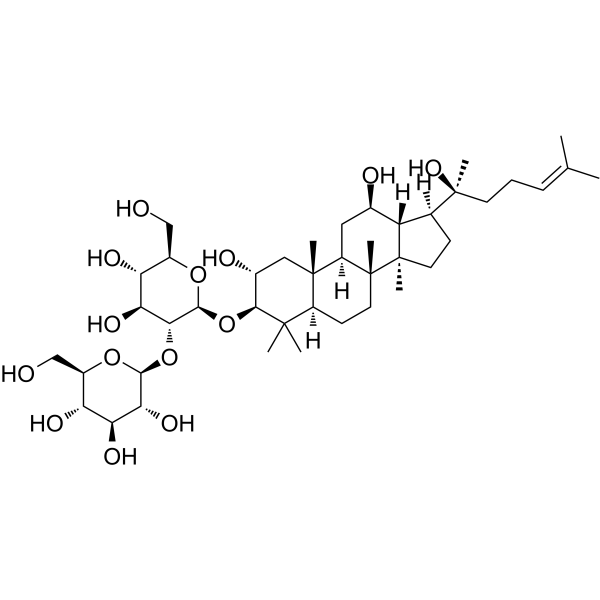Gypenoside L
Modify Date: 2024-01-14 11:33:31

Gypenoside L structure
|
Common Name | Gypenoside L | ||
|---|---|---|---|---|
| CAS Number | 94987-09-4 | Molecular Weight | 801.01 | |
| Density | 1.33±0.1 g/cm3(Predicted) | Boiling Point | 912.3±65.0 °C(Predicted) | |
| Molecular Formula | C42H72O14 | Melting Point | N/A | |
| MSDS | N/A | Flash Point | N/A | |
Use of Gypenoside LGypenoside L is a saponin that can be found in Gynostemma pentaphyllum. Gypenoside L increases the SA-β-galactosidase activity, promotes the production of senescence-associated secretory cytokines. Gypenoside L also can activate p38 and ERK MAPK pathways and NF-κB pathway to induce senescence. Gypenoside L exhibits anti-tumor and anti-inflammatory activities[1][2]. |
| Name | Gypenoside L |
|---|
| Description | Gypenoside L is a saponin that can be found in Gynostemma pentaphyllum. Gypenoside L increases the SA-β-galactosidase activity, promotes the production of senescence-associated secretory cytokines. Gypenoside L also can activate p38 and ERK MAPK pathways and NF-κB pathway to induce senescence. Gypenoside L exhibits anti-tumor and anti-inflammatory activities[1][2]. |
|---|---|
| Related Catalog | |
| In Vitro | Gypenoside L (20-80 μg/mL; 24 h) increases the mRNA expression levels of SASP, such as IL-1α, IL-6, TIMP-1, CXCL-1 and CXCL-2 in HepG2 and ECA-109 cells[1]. Gypenoside L (20-80 μg/mL; 24 h) causes cell cycle arrest at S phase[1]. GPL (3.125-100 μg/mL) significantly inhibits LPS-induced NO accumulation in RAW264.7 cells[2]. |
| References |
| Density | 1.33±0.1 g/cm3(Predicted) |
|---|---|
| Boiling Point | 912.3±65.0 °C(Predicted) |
| Molecular Formula | C42H72O14 |
| Molecular Weight | 801.01 |